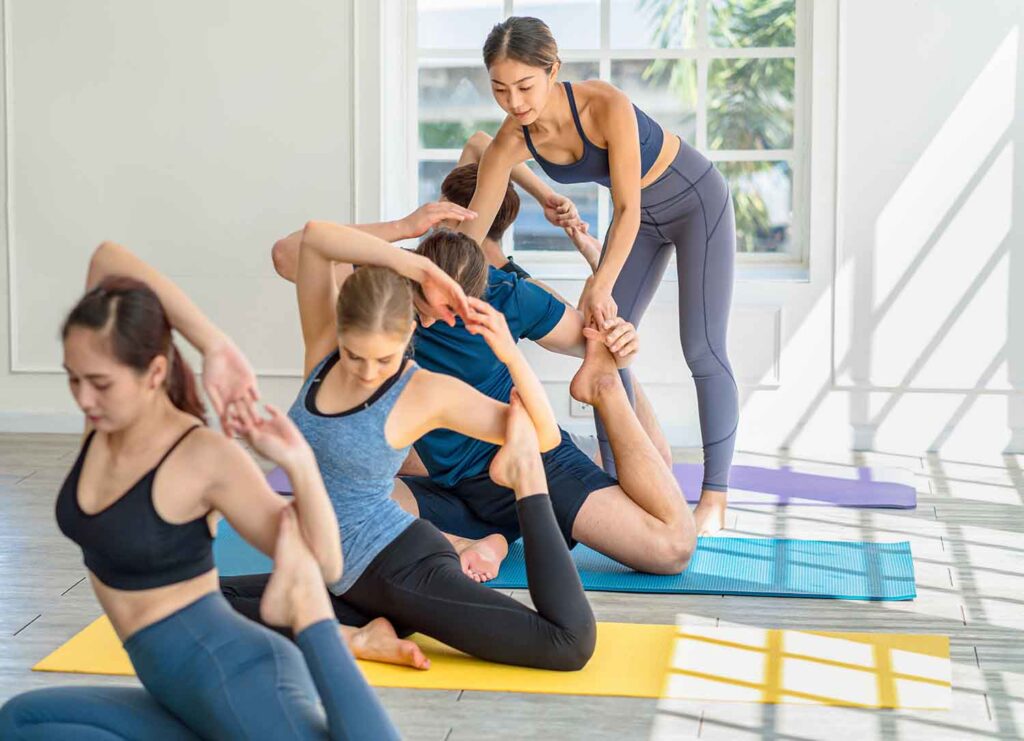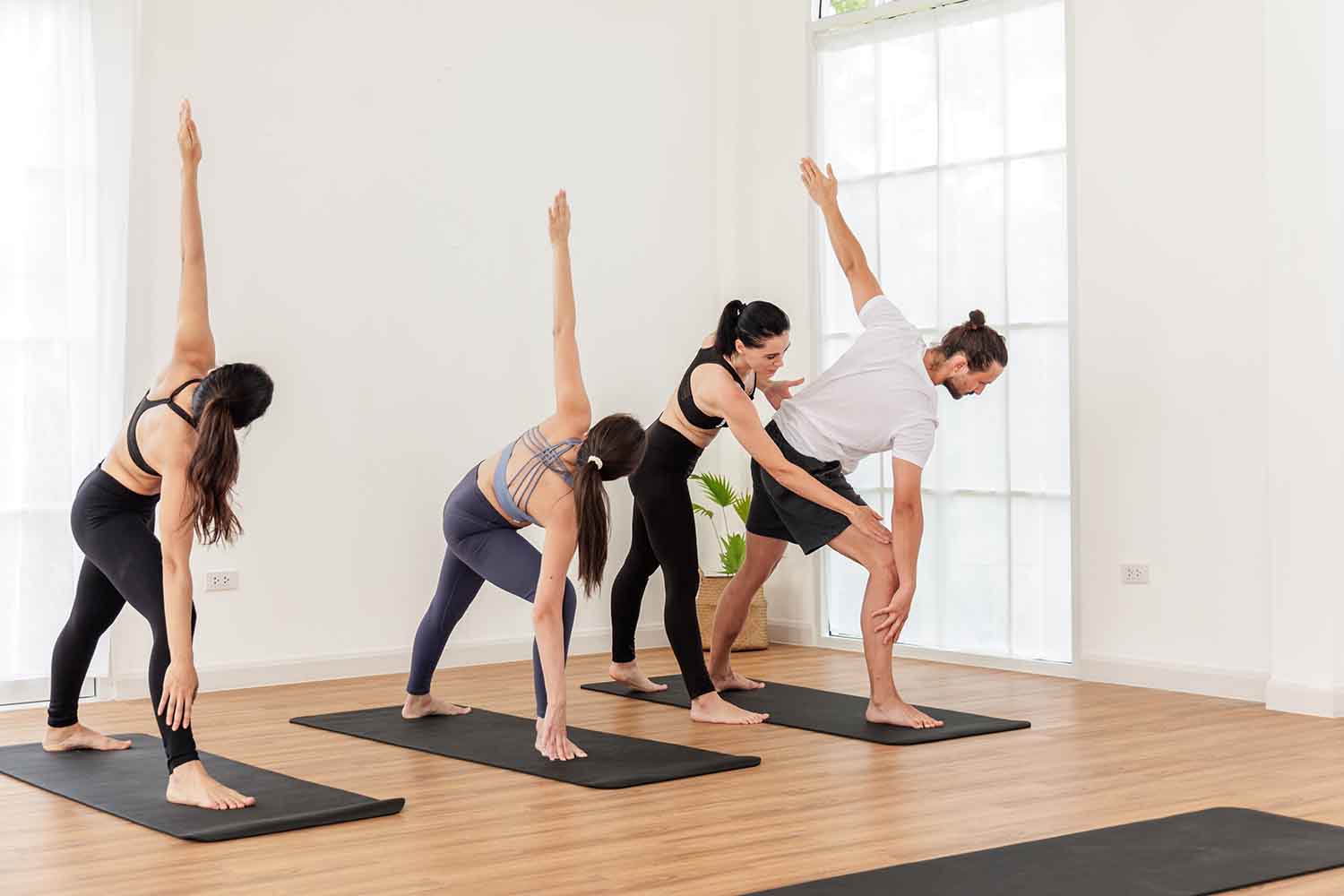Welcome to our comprehensive guide on “How to Teach a Yoga Class: Tips for Yoga Teachers on Teaching a Yoga Class Effectively.” Whether you’re a seasoned instructor looking to refine your technique or a newly certified teacher eager to embark on your journey, this page offers valuable insights and practical advice. From mastering the art of cue delivery and sequencing to creating a positive and inclusive environment, we aim to empower you with the tools required for a transformative class. Dive into expert tips and discover how to make each session a harmonizing and fulfilling experience for both you and your students.
How to Be a Confident Yoga Teacher and Let Your Personality Shine
Teaching yoga effectively means embracing your role as a teacher with confidence and allowing your personality to shine. New teachers often feel overwhelmed, but with practice, you’ll find your rhythm. Veteran teachers advise balancing a well-structured plan with the flexibility to adapt. Keep a set of “back-pocket” sequences ready to make transitions smoother and maintain flow.
Don’t underestimate the power of effective communication; speak in a way that serves your students during the practice. It’s essential to make them feel comfortable and supported. Remember, simplicity is key when teaching. You don’t need to rush through poses; instead, holding poses can help build strength and endurance.
Efficient class management includes creating a welcoming space that encourages openness and participation. Teachers who engage in continuous personal development often bring fresh insights into their classes. This approach not only enhances your teaching but also helps students make deeper connections with their practice. Be patient with yourself; even seasoned teachers continue to grow. Embrace your unique teaching style and let it flourish

Building Self-Assurance in Teaching Yoga Classes
Building self-assurance in teaching yoga classes is essential for any yoga teacher aiming to conduct a class effectively. The journey to becoming a confident teacher starts with understanding your strengths and conveying them to your students. Take the time to prepare each class thoroughly, as preparation helps reduce stress and boosts confidence. Encountering challenges is natural, but over time, you’ll find that each class helps you become more adept at managing diverse student needs. Encourage your students to communicate openly; their feedback can provide valuable insights for your improvement. It’s vital to talk to your students during the class, offering guidance and making sure they feel comfortable throughout their practice. Embrace your unique teaching style and let your personality come through each time you lead a session. Over time, your self-assurance will grow, making you a more inspiring and effective teacher. Remember, an empowered teacher creates an empowered class environment, which benefits everyone involved. Your self-belief will naturally radiate confidence to all your students.
Preparing Your First Yoga Class: What to Consider
Preparing your first yoga class calls for careful planning and attention to detail to ensure a successful session for you and your students. Consider the level of students you’ll be teaching, as this will guide the yoga sequence you craft. Engage in initial yoga training to build the confidence needed to lead a class effectively. Each session should have a clear objective to keep the class focused. When you prepare, think about the kind of atmosphere you want to create—calming, invigorating, or balanced. This planning is essential for how you present each segment of the session. It’s crucial to make your sequence realistic for the time available, ensuring students leave feeling accomplished. Apply these teaching techniques to ensure your first class is not only organized but enjoyable for all, setting a positive tone for your yoga teaching journey. Ready to start planning your class? Don’t hesitate to reach out to fellow teachers for advice and inspiration. Now, go ahead and make your first yoga class a memorable one!
Step-by-Step Guide to Teaching Yoga Successfully
To teach a yoga class effectively, begin with thorough preparation. First, familiarize yourself with the sequence to build comfort in guiding students through each pose. Training your mind to flow naturally from one yoga pose to another enhances your confidence in leading the class. Create a welcoming environment where people feel encouraged to practice regularly. During the class, emphasize the importance of each pose by providing clear instructions, ensuring students understand alignment and modifications. Instruct students to focus on their breath as they move through each transition, enhancing their overall practice experience. Encourage moments of rest, like savasana, providing students with time to reflect and absorb the benefits of their practice. Engage with students by offering personalized feedback and adjustments, helping them improve their individual practice and alignment. Remember, each class is an opportunity to teach people something new and enhance their enjoyment of yoga. Finally, conclude the session by reflecting on what you’ve achieved, thanking students for their participation, and offering them guidance they can incorporate into their daily life.
- Define your theme – Set an intention (e.g., grounding, heart-opening, stress relief).
- Sequence smart – Warm-up, peak pose, cool down. Build gradually.
- Know your audience – Tailor to beginners, advanced, or specific needs.
- Balance movement & breath – Cue breathing throughout transitions.
- End with stillness – Always include Savasana or a meditative close.

Tips on Balancing Planning and Spontaneity
Balancing planning and spontaneity is essential for yoga teachers aiming to deliver effective classes. Veteran teachers emphasize that while having a well-thought-out yoga sequence is crucial, it’s equally important to adapt on the spot for a more dynamic teaching experience. By integrating planning and spontaneous adjustments, teachers can better address the needs of their students, ensuring everyone walks away feeling enriched. It’s beneficial for teachers to understand their students’ capability and energy levels, tweaking their yoga practice to meet the moment.
Time management plays a pivotal role here; teachers should allocate time for individual adjustments within the sequence. The practice becomes not just a routine but a transformative experience when teachers combine both planning and spontaneity.
Teachers who’ve been doing this for years understand that spontaneity doesn’t mean chaos, but rather a refined art of responsiveness. Being both planned and adaptable allows teachers to be in tune with their students, making each yoga session special and impactful. Embracing both approaches transforms their teaching from basic to masterful.
Planning Your Yoga Class Effectively
When planning your yoga class effectively, it’s essential to develop a comprehensive plan that caters to both beginner and advanced practitioners. Start by making a clear outline of your class objectives, which ensures your teaching remains focused and purposeful. Allocate time each day to refine your plan, considering the details that will make your class engaging and balanced. Perhaps draw inspiration from veteran teachers who have perfected their craft over the years.
When planning your class, incorporate a variety of poses that align with your teaching style and address the needs of your students. Remember, balance is key; don’t overload your class with information, but make sure it challenges the students appropriately. By planning effectively, you can enhance the learning experience and help students grow in their practice. Teachers should reflect on each session after the day is over, identifying what worked and where improvements can be made. This deliberate planning and reflection process ensures your classes stay dynamic and rewarding, keeping students engaged throughout the years.
Speak in a Way That Serves Your Students During Yoga Practice
When you’re a yoga teacher, how you speak is just as important as what you teach. Communicating clearly helps create a supportive environment, allowing students to focus on their practice. Effective yoga classes are those where instructors talk in a way that resonates with their students’ needs. Concentrating on how you speak can bridge the gap between novice and experienced participants, ensuring everyone benefits from the session. It’s vital for teachers to adapt their communication style, understanding the dynamics of each class. Speaking in a calm, encouraging manner can instill confidence in students, helping them achieve their yoga goals. Whether you’re providing detailed instructions or gentle corrections, ensure your language is supportive, using words that motivate rather than discourage. Yoga teachers who master the art of effective communication often notice a significant improvement in student engagement. This balance in how you talk and communicate is more than just words; it’s about creating a safe, welcoming space where students feel valued and encouraged to explore their yoga journey with confidence.
Communicating Effectively in a Yoga Class
Communicating effectively in a yoga class is essential for both the instructor and the students. From the moment students step onto their mat, it’s crucial to create an environment where everyone feels heard and understood. As you start the lesson, take a few minutes to outline the class layout, ensuring that every student knows what to expect and feels at ease. During this time, don’t hesitate to encourage dialogue; questions and feedback can help tailor the class to meet the needs of your students. Remember, a successful yoga class isn’t just about the poses; it’s also about how you communicate intentions and modifications to make everyone feel included. Teaching involves not only guiding the practice but also listening actively to students’ concerns or preferences. This way, every participant leaves the mat feeling empowered and enriched. As you plan your lesson, think about the key points you want to convey and how you’ll adapt when spontaneous teaching moments arise. This approach ensures every class feels dynamic and responsive.
Managing Your Class Like a Pro: Essential Tips for Yoga Teachers
Managing your yoga class like a pro requires more than just knowing the poses. As a yoga teacher, it’s essential to create a harmonious environment that allows students to focus on their practice and make the most of their time on the mat. An effective teacher knows how to tailor their teaching methods to accommodate different abilities and energy levels, ensuring each class is a fulfilling experience for students. It’s important to plan your yoga classes with flexibility in mind, giving yourself space to adjust the lesson structure based on the class’s mood and energy. Incorporate elements into your teaching that encourage engagement and attentiveness, like calling attention to their posture by asking them to focus on how their body feels on the mat. A well-managed class is not only about guiding students through yoga poses but also about creating an inclusive and supportive atmosphere. With practice and awareness of your students’ needs, you can establish yourself as a teacher who knows how to manage each class effectively, helping students thrive on and off the mat.
Create a comfortable space
As a yoga teacher, one of your primary goals is to create a comfortable space for your students that enhances their yoga practice. Start by ensuring the room is free from distractions and has a welcoming atmosphere. Arrange the yoga mats with enough space in between, allowing each participant to feel at ease during their poses. The aim is to make your students feel supported, whether they’re attempting a new pose or settling into their practice. Adjust lighting and temperature to make the environment more inviting. Soft lighting and a comfortable room temperature can profoundly affect how students feel during practice. Use calming scents or gentle music to enrich the atmosphere, but be mindful of your students’ preferences. Their comfort is key, and your focus should be on nurturing an environment where they can explore their yoga practices safely. A well-arranged space where they don’t feel restricted or crowded makes all the difference in how they engage with their yoga mat and enhances the overall experience.
Keep it Simple
When it comes to teaching a yoga class, a fundamental tip for any teacher is to keep it simple. Simplicity in your lesson plan can make a significant difference in how students receive each yoga pose. By focusing on clear, uncomplicated guidance, you ensure that everyone understands the flow without feeling overwhelmed. As a yoga teacher, your goal is to create a calm and focused atmosphere, where students can concentrate on their breath and practice. Keeping it simple helps allocate more time to ensuring each pose is performed correctly, and that everyone is comfortable transitioning into savasana. A straightforward approach also allows the teacher to adapt in real-time, responding to the class’s energy and needs as they shift. When crafting your lesson, remember that the simplicity of your teaching not only helps your students maximize their experience but also makes it easier for you to manage the class effectively. Simplifying your approach can also make teaching more enjoyable, leading to a more rewarding experience for both teacher and student alike.
In conclusion, teaching a yoga class effectively requires a blend of knowledge, preparation, and empathy. Embrace continuous learning and adapt your teaching style to suit your class’s needs. By incorporating these tips, such as creating a safe environment, offering clear instructions, and maintaining a positive energy, you can inspire and elevate your students’ yoga experience. Remember, the true art of teaching yoga lies in nurturing a space where individuals can connect with their practice on a deeper level. Keep evolving as a yoga teacher, and you will find fulfillment in guiding others on their journey to wellness

